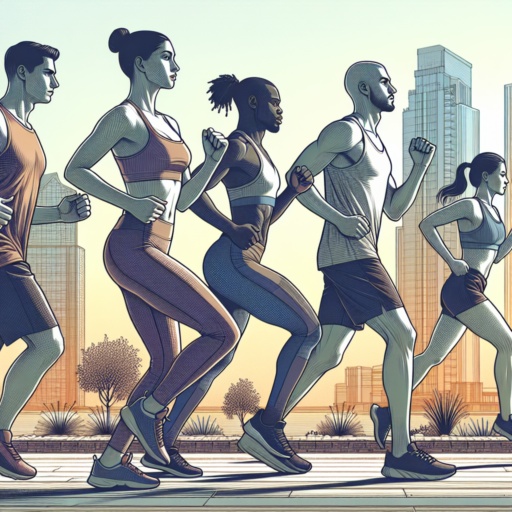Understanding the Basics of Track Running: Indoor vs Outdoor
When diving into the world of track running, it’s crucial to grasp the fundamental differences between indoor and outdoor tracks. This not only helps athletes prepare more effectively but also guides beginners towards making informed decisions about their training environments.
Track Composition and Design
One of the first differences newcomers notice is the track composition and design. Outdoor tracks typically measure 400 meters per lap, offering a standard for competitions worldwide. These tracks are often made from synthetic materials that cushion runners’ joints against the harsh impacts of sprinting and long-distance running. In contrast, indoor tracks, designed to fit within smaller, enclosed spaces, usually extend only 200 meters and feature tighter turns. The composition of these tracks varies but is geared towards maximizing space while minimizing joint strain in a climate-controlled environment.
Climate and Seasonal Training
Another pivotal distinction lies in the climate and seasonal training opportunities each setting presents. Outdoor track running embraces the unpredictability of weather, preparing athletes for various conditions they might face during competitions. This aspect of training is crucial for developing adaptability and resilience. On the flip side, indoor tracks offer a consistent environment free from the variables of weather, allowing athletes to train effectively regardless of outside conditions. This consistency is particularly beneficial during winter months in colder regions, where outdoor training might not be feasible.
Impact on Performance
The choice between indoor and outdoor track running can also influence an athlete’s performance. Running on an outdoor 400-meter track allows for a more natural long-distance rhythm, critical for events like the 5,000 or 10,000 meters. Meanwhile, the tighter turns and shorter laps of indoor tracks can enhance an athlete’s speed and agility, proving advantageous for shorter races and sprints. Understanding these nuances helps runners tailor their training to meet specific event requirements, potentially boosting their competitive edge.
The Significant Design Variations Between Indoor and Outdoor Tracks
Exploring the differences in design between indoor and outdoor tracks reveals much about the unique challenges and requirements of each. While both share the fundamental purpose of facilitating races and athletic training, their design features cater to specific environmental and spatial considerations. From surface materials to the geometry of the track, the distinctions play crucial roles in athlete performance and safety.
Surface Materials and Track Composition
One of the most noticeable differences lies in the surface materials and composition of the tracks. Outdoor tracks typically feature rubber or other weather-resistant materials to withstand elements like rain, sun, and temperature variations. In contrast, indoor tracks may use more varied materials, including wooden surfaces, providing a different level of traction and impact absorption essential for athlete’s long-term joint health and immediate performance metrics.
Track Geometry and Lane Specifications
The geometry and specifications of lanes significantly diverge between indoor and outdoor tracks, as indoor tracks often have fewer lanes and a tighter curve radius. This architectural choice compensates for the limited space within indoor facilities but introduces unique challenges, such as increased centrifugal force on athletes, leading to faster fatigue rates. Outdoor tracks, conversely, usually adhere to international competition standards more closely, offering wider lanes and more gradual curves that accommodate high-speed sprints and relays more effectively.
How Track Surface Impacts Athletes’ Performance: Indoor vs Outdoor Comparison
The impact of track surface on athletes’ performance is a topic of considerable interest among sports scientists and athletes alike. Different surfaces, particularly those found in indoor and outdoor settings, can significantly affect an athlete’s speed, energy expenditure, and injury risk. This comparison aims to shed light on how these two environments can offer diverse challenges and benefits to athletes.
Material Composition and Performance
Indoor tracks often feature synthetic surfaces, designed to provide a consistent texture that aids in the reduction of impact stress on athletes’ joints and muscles. This consistency can be beneficial for athletes prone to injury or those in the process of rehabilitation. On the other hand, outdoor tracks can vary widely, from synthetic materials to natural surfaces like cinder or grass. The variability of outdoor surfaces requires athletes to adapt constantly, which can positively affect their agility and endurance but might also lead to increased injury risk due to uneven or harder surfaces.
Environmental Influence on Energy Expenditure and Speed
The environmental conditions indoor and outdoor tracks expose athletes to can markedly influence their performance. Indoor environments offer controlled climate conditions, which can lead to better energy conservation and potentially improved performance outcomes. In contrast, outdoor tracks subject athletes to a variety of weather conditions, from high temperatures to wind, that can increase energy expenditure and affect speed. Navigating these conditions can offer crucial experience for athletes, especially those competing in outdoor events, but it also introduces variables that can impede performance.
Comparing the Length of Indoor and Outdoor Track Events
When discussing track and field events, one significant aspect that differentiates indoor from outdoor competitions is the length of the track itself. Indoor tracks, often housed within arenas or facilities designed for multiple sports, are typically shorter in length than their outdoor counterparts. This variance directly impacts the distance of the track events held within these venues.
Standard Length of Indoor Tracks
Indoor tracks usually measure around 200 meters per lap, a size constrained by the limited space within indoor venues. This length is exactly half of the standard 400-meter outdoor track lap. Due to this size limitation, indoor track events such as sprints, hurdles, and distance races are adjusted accordingly. For instance, a common indoor track event is the 60 meters sprint, a shorter counterpart to the 100 meters sprint found in outdoor competitions. The indoor environment also affects the number of laps for longer races, doubling the effort to match outdoor distances.
Impact on Athlete Training and Strategy
The difference in track lengths necessitates distinct training regimes and strategies for athletes. Indoor tracks feature tighter curves due to their smaller size, which can significantly influence a runner’s technique and speed. Athletes must adapt to these conditions, emphasizing agility and acceleration to maintain momentum. Conversely, outdoor tracks allow for greater speed and endurance development over longer distances, with environmental factors such as wind resistance playing a crucial role in training. Understanding these nuances is essential for competitors transitioning between indoor and outdoor seasons.
Indoor vs Outdoor Track: Analyzing the Differences in Atmosphere and Environment
When it comes to track events, athletes and spectators often debate the merits and experiences of indoor vs outdoor venues. Each setting offers a distinct atmosphere and environment, influencing not only the performance of the athletes but also the viewing experience of the audience. Understanding these key differences is essential for appreciating the nuances of track and field events.
Air Quality and Climate Control
One of the most noticeable differences between indoor and outdoor tracks is the air quality and the climate control. Indoor facilities benefit from a controlled environment, which means temperatures are consistent, and conditions are predictable. This can be particularly advantageous during colder months or in variable weather, as it ensures athletes can perform without the hindrance of adverse weather conditions. However, the controlled climate of indoor tracks may not offer the same air quality as outdoor tracks, where fresh air circulation is more abundant but environmental conditions are far less predictable.
Surface and Space Constraints
Another significant difference lies in the surface and space constraints of indoor vs outdoor tracks. Outdoor tracks typically offer a standard 400-meter circuit, providing athletes with ample space for long-distance events and the opportunity to compete in a more natural, open environment. In contrast, indoor tracks are usually shorter, often measuring 200 meters, which necessitates tighter curves and can affect athletes’ strategies and performances. The tighter indoor spaces and harder surfaces can also influence the type and severity of injuries athletes might sustain, making proper training and preparation crucial.
The atmosphere of indoor tracks is often described as more intimate and intense, due to the proximity of spectators to the action and the echo of cheers within an enclosed space. This can create a vibrant and energizing environment for competitors, albeit sometimes more pressurized. Outdoor tracks, conversely, boast a vastness that can dilute sound but also allows for a more relaxed experience, where the natural elements play a more significant role in the day’s events. The sense of openness and connection to the outdoors can offer a different type of solace and inspiration for athletes and spectators alike.
Weather Influence on Track and Field Events: Indoor vs Outdoor Perspectives
The performance of athletes in track and field events is significantly influenced by the weather conditions, especially when comparing indoor and outdoor settings. Indoor events, shielded from the variabilities of weather, offer a controlled environment that ensures consistent conditions such as temperature, humidity, and air quality. This consistency is imperative for athletes as it allows for optimal performance and reduces the risk of weather-related injuries.
Conversely, outdoor track and field events present a dynamic challenge due to the unpredictability of weather. Factors such as wind speed and direction, precipitation, and temperature fluctuations can significantly impact the performance outcomes of athletes. For instance, wind speed can either advantage or disadvantage athletes in sprinting events or long jumps, directly affecting the distance achieved or the speed maintained. Temperature variations can also influence an athlete’s ability to maintain optimal performance levels, with extreme temperatures leading to risks of overheating or hypothermia.
Moreover, the psychological impacts of weather conditions on athletes can’t be overlooked. The anticipation and adaptation to changing outdoor conditions demand a higher level of mental resilience and flexibility. Athletes competing in outdoor events must be prepared for quick adjustments in strategy and technique, which adds an additional layer of complexity to their performance readiness. Indoor environments, by removing these variables, allow athletes to focus solely on their performance without the added stress of environmental adaptability.
No se han encontrado productos.
The Role of Air Quality and Ventilation in Indoor vs Outdoor Tracks
When we consider the performance and comfort of athletes and casual runners alike, the role of air quality and ventilation cannot be overstated, especially when contrasting indoor vs outdoor tracks. Indoor environments often rely on controlled ventilation systems to maintain air quality, but the effectiveness of these systems can vary greatly. In contrast, outdoor tracks benefit from natural air flow, but the quality of this air can be impacted by external factors like pollution and pollen levels.
Indoor tracks have the advantage of sheltering athletes from external air quality variables such as industrial pollution or high pollen counts. However, the reliance on artificial ventilation systems means that the management of CO2 levels, humidity, and temperature must be carefully balanced to ensure a healthy environment. Poor ventilation in indoor spaces can lead to the buildup of harmful pollutants, which can affect the respiratory health of the athletes and impair performance.
On the other hand, outdoor tracks offer the benefits of natural ventilation, which can ensure a fresh air supply that is often perceived as more invigorating and healthier. Nevertheless, the uncontrollable nature of outdoor air quality means that athletes are at the mercy of environmental conditions, with issues such as smog, wildfire smoke, or even just the day-to-day fluctuations in air quality indices potentially impacting their health and performance.
Equipment and Shoe Considerations for Indoor and Outdoor Track Athletes
When it comes to maximizing performance and ensuring safety on the track, both indoor and outdoor athletes must give precedence to their equipment and shoe selection. The right gear can considerably alter an athlete’s experience, translating to improved times and reduced risk of injury. In particular, the differentiation between indoor and outdoor environments brings about unique challenges, pushing athletes to consider gear that is specifically designed for the conditions they will face.
For indoor track athletes, the emphasis on shoes revolves around lightweight design and optimal grip. Indoor tracks usually consist of synthetic materials that can potentially be slippery. Hence, shoes with a superior grip are crucial to prevent slipping and to enhance the athlete’s ability to maintain speed around tighter turns. Additionally, the absence of natural elements means indoor shoes can focus more on performance rather than durability.
Outdoor track athletes, on the other hand, have to account for a variety of surfaces and weather conditions. From sun-baked tracks that can get extremely hot to wet conditions that can lead to slippery surfaces, the demand for versatility in shoe and equipment choice is evident. Here, shoes need not only to provide good grip but also to offer adequate support and cushioning to absorb the impact from harder surface materials like asphalt or concrete. Moreover, outdoor gear must also incorporate elements of durability to withstand wear and tear from the elements.
Training Adjustments for Competing on Indoor Versus Outdoor Tracks
Adjusting training strategies for athletes competing on indoor versus outdoor tracks is crucial due to the distinct characteristics and challenges each environment presents. Indoor tracks typically feature shorter laps, often 200 meters, compared to the standard 400 meters of outdoor tracks. This distinction alone demands a shift in emphasis towards speed, agility, and the ability to rapidly accelerate. Athletes must adjust their training to focus more intensely on speed drills and shorter, more explosive interval training to adapt to the faster pace and tighter turns of indoor tracks.
Another significant factor to consider is the indoor track surface. Indoor tracks are often made from different materials than outdoor tracks, potentially affecting traction, speed, and how an athlete’s shoes interact with the track. To prepare adequately, athletes should include sessions that mimic the indoor track conditions as closely as possible. Training on similar surfaces can help in adjusting technique and identifying the most suitable footwear to enhance performance while reducing the risk of injury.
The controlled climate of indoor venues is also a noteworthy difference from the unpredictable outdoor conditions. Outdoor track athletes must be prepared to compete in a wide range of weather scenarios, from hot, sunny days to cold, windy conditions. Indoor athletes, however, need to acclimate to racing in a stable, yet often drier and warmer environment. Incorporating heat acclimatization strategies and hydration tactics can be beneficial for those transitioning from outdoor to indoor competition settings. Regular exposure to warmer temperatures during training sessions can aid in this acclimation process, ensuring optimal performance on the day of an indoor event.
Choosing Between Indoor and Outdoor Track: What Every Athlete Needs to Know
When it comes to deciding between indoor and outdoor track, athletes are faced with a unique set of considerations that can significantly influence their training and competitive outcomes. Understanding these differences is essential for making an informed decision that aligns with your personal athletic goals and preferences.
Environmental Factors
The environment plays a huge role in shaping the indoor and outdoor track experience. Indoor tracks, often located in controlled settings, offer protection from the weather, ensuring consistent conditions that can lead to more reliable performances. However, the typically shorter length of indoor tracks (usually 200 meters) means more laps are necessary, which can affect pacing and strategy. In contrast, outdoor tracks provide a standard 400-meter length, but athletes must contend with variable weather conditions, which can introduce unexpected challenges or advantages.
Physical Demands
Differences in surface and atmosphere also contribute to the distinct physical demands of indoor and outdoor tracks. Indoor environments can be drier, potentially affecting respiratory comfort, while the softer surface of an indoor track may be easier on the joints. Outdoor track athletes, on the other hand, must adapt to a wide range of temperatures and potentially harder surfaces, which can influence endurance and injury risk. The skill to adapt to these conditions is crucial for competitive success in either setting.




